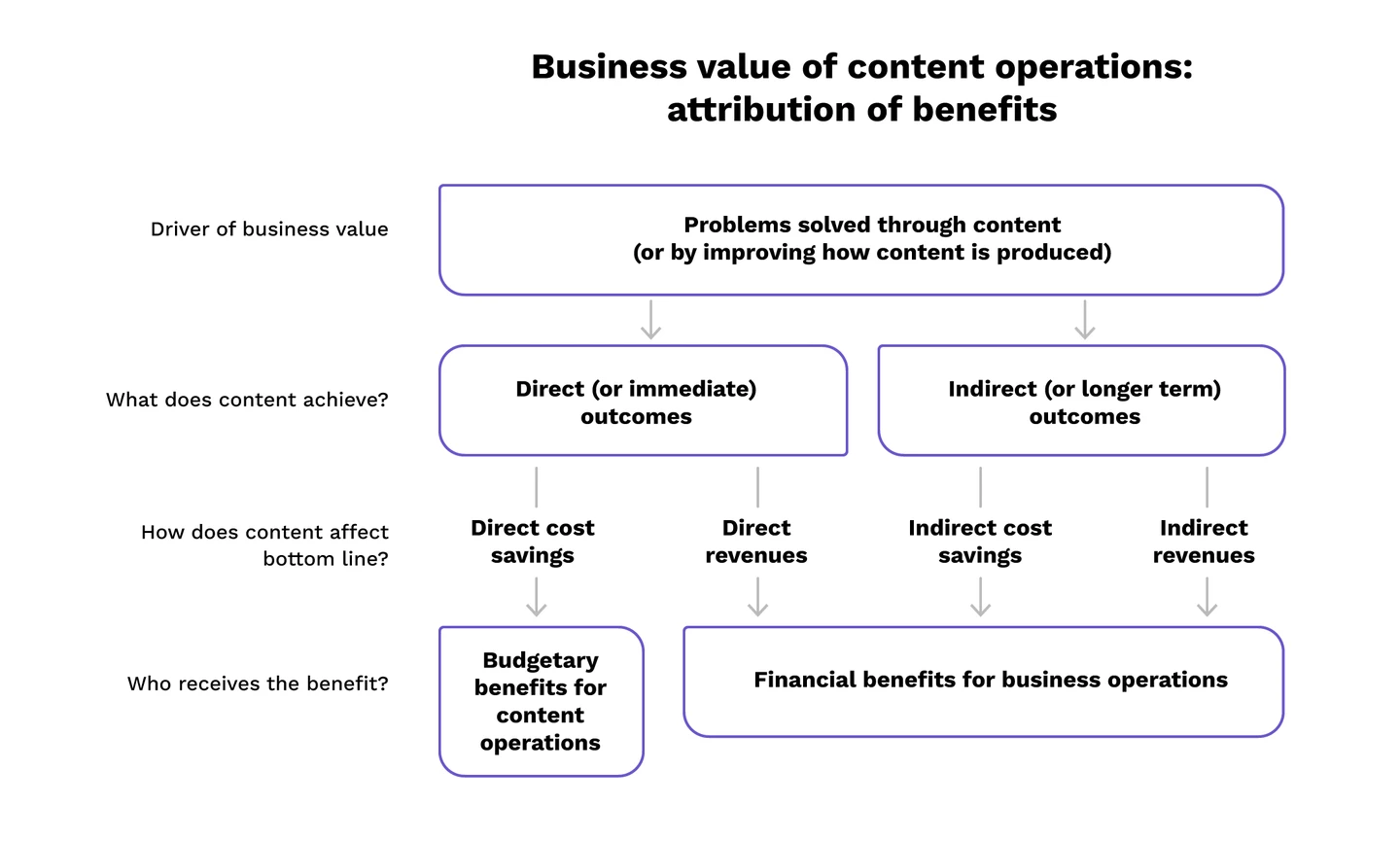Why invest in generative AI for content?
Will your business become more profitable if it invests in generative AI for content? Learn how investing in AI can boost financial benefits from your content.
Written by Michael Andrews

Will your business become more profitable if it invests in generative AI for content? Learn how investing in AI can boost financial benefits from your content.
Written by Michael Andrews

Content is about to become much more valuable. Since the beginning of the internet, digital content has been expensive to produce because it requires loads of time-consuming manual labor. And because of its expense, content has been hobbled. Lots of content is produced that’s of questionable quality or relevance, rushed through without adequate attention or support, or left untouched after publication. Other content doesn’t get published because staff don’t have time to do so. Selective high-quality content does get published, but because it entails so much manual effort, only certain kinds of content are considered important enough to get high-touch treatment.
The high cost of manual content production has limited the impact that content can deliver to the bottom line of corporations. But not for long. Generative AI will change how content is developed so that organizations don’t have to ration the support they provide to content. Enterprises can develop better-quality content that will boost their bottom-line results.
AI provides the opportunity to break through the cost barriers that have limited content’s impact.
AI presents a major inflection point in enterprise business operations. Executives are seeking clarity about the bottom-line benefits of adopting generative AI. For the first time, many are thinking seriously about the value of the words their organization produces and delivers online. How important is their content, can it be produced in a better way, and should the firm invest in generative AI to change how content is developed?
These questions are no longer solely the concern of content specialists. They are gaining attention in the upper reaches of management. Executives sense a significant transformation is underway and wonder how they need to respond.
Enterprises have undergone many years of “digital transformation” – important work, but work that hasn’t changed content processes significantly. Unlike prior technology transformations such as Big Data and robotic process automation, generative AI is explicitly focused on content. It will recalibrate employee expectations about the value that content can deliver to the business.
To get value from content, you need to understand how and where content delivers financial value. Organizations can have trouble agreeing on the business value of content. Salespeople expect content to lead to more sales revenue and may fault bad content for missed sales targets. Financial staff sees content strictly as a cost whose value doesn’t appear on the balance sheet. The HR department views content as an operational necessity required to enable employee recruitment, training, and retention. The customer support team considers content as an essential tool for them to do their work and keep customers happy. All these perspectives are true, but none of them by themselves fully captures the value of content to a business.
Content can support a range of business goals, and the monetary contributions of each will be different. Moreover, many forms of content support multiple goals in both the short and long term. These factors can sometimes lead people to oversimplify the impact of content by seeing content solely in terms of its costs or a directly measurable revenue event.
Content’s value should be examined comprehensively in terms of its impact on company-wide profitability and how it influences revenues and operational expenses.
Producing content represents an expense. The simplest way to reduce content costs is to produce less content since fewer employees will be needed, and salaries account for a high portion of the expense of creating content. But limiting the amount of content will preclude the possibility of using content to reduce business operating expenses or increase revenues. A more sophisticated approach to containing costs is to produce content in a smarter way that allows the organization to create more and better content using the same number of employees while reducing the amount of time employees need to spend on tasks.
Content can support business profitability in multiple ways. The below table shows some of the ways that content can, directly and indirectly, boost revenues or reduce costs.
Scroll horizontally to see more →
The motivating goal for creating content is not to minimize the money spent but to solve customer or employee problems – problems that have a far larger monetary value in the aggregate. When content is viewed solely as a cost, organizations are unable to realize full value from the content they produce because they will focus entirely on minimizing the role of content operations.
Content operations have a broad influence on the costs and revenues of nearly all business units and functions within enterprises. All parts of enterprises rely on content for essential business functions. Content is now the primary means of communicating with customers and employees. For example, a recent McKinsey study notes the growing extent that enterprise buyers rely on content: “Many are happy to close deals in excess of $500,000 without ever meeting the seller in person.“
Person-to-person interactions happen only when content can’t provide needed information. Content embodies the collective knowledge of the enterprise. Every time a customer can get an answer without having to talk to an employee, or an employee gets an answer without needing to ask a colleague, it will reduce operating expenses.
The total financial benefit of content operations far exceeds the budgetary costs required to run them. That means that any opportunity to make content more effective has a multiplier effect on business success.
Content value derives from outcomes that the content directly influences and outcomes it indirectly influences by facilitating desired results. Outcomes can belong to one or more of four types:

Content supports numerous business operations functions, which both directly and indirectly benefit from the content. The financial benefits accrued from published content are often enjoyed by a different part of the organization than the organizational unit producing the content. This organizational separation of the content operations from the business operations that the content is supporting can mask the contribution of the content to the resulting business outcomes.
Don’t prioritize content funding and outcomes separately. When the costs to produce content are considered separately from the outcomes the content produces, it can be difficult to establish whether the resources supporting content were sufficient to enable the desired outcomes. Sometimes the funding for content operations is inadequate as a result. When this is the case, the resourcing level supporting the content becomes a constraint on realizing desired financial benefits.
Content’s contributions to profitability are best considered on a company-wide basis rather than based on its budgetary impact on individual cost centers. Enterprise content operations achieve more effective outcomes when resources and practices are shared across various business divisions. It reduces duplication of effort and equalizes standards, resulting in better content performance.
Three factors exert a major influence on the impact content can achieve:
Each of these factors can impact internal costs as well as external (customer) revenues and loyalty. The below table illustrates some ways that quality, speed, and scale impact costs and revenues.
Scroll horizontally to see more →
While quality, speed, and scale all improve outcomes, they are difficult to achieve with manual content publishing. Both quality and scale require large numbers of employees. And both work against the goal of speed.
Until recently, enterprises relying on legacy content management practices haven’t been able to overcome the costs associated with improving quality, speed, and scale. This cost barrier has resulted in the persistence of problems in the quality, speed, and scale of the content produced.
Generative AI changes the picture.
The difficulties that content operations face delivering quality content, at a fast speed, and at scale don’t just inconvenience content teams. They constrain the whole enterprise.
Adopting generative AI can improve business outcomes by making content:
Generative AI can achieve better outcomes by improving three key dimensions influencing content performance mentioned previously:
Content quality is an umbrella concept that’s difficult to capture using a single metric. Yet quality isn’t a subjective characteristic of content that’s dependent on whether an internal stakeholder likes the content or not. Numerous corporate and third-party standards are available that define the content quality characteristics. Quality can be tested empirically with readers and tracked with analytics to confirm whether the content is meeting their expectations.
While content quality has multiple dimensions, most fall within one of two categories:
Low-quality content is a wasted expense since the expenditure doesn’t accomplish what it should. Customers will ignore or misunderstand the low-quality content, causing problems elsewhere in the business.
New initiatives often need fresh content and writers to create that content. Continuing initiatives, in contrast, don’t get as much budget for content. Enterprises can make the mistake of ranking content importance solely in terms of their current willingness to spend on writers to create new content. When that happens, budgets decide the content’s importance rather than customer or employee needs and the associated financial benefits of solving their problems.
Avoid the mistake of thinking that only some content is important enough to be made well. If certain content is deemed as not important, it will have corners cut on its quality (the attention given to its understandability, accuracy, and relevance), and it will reliably perform in line with the low expectations that were given to it.
Even if not everyone realizes why poor-quality content gets published, enterprises are starting to recognize that the issue prevents them from meeting business objectives. Employees frequently hear one department complain about another department failing to do their job informing customers about essential information. Missing or substandard content is often a weak link in business operations. Yet because the problem can be diffused and hard to diagnose, its solution may seem elusive.
By analyzing content processes as a value chain, we can break the problem and its solution into three parts:
Enterprises need a solution to quality problems that can address all content, not just select content that receives special attention. Recall that we want solutions that deliver quality at scale. Levels of staffing and expertise are typically not even across an enterprise. Generative AI points to a practical way to provide quality at scale. Content quality no longer depends as strongly on staff budgets.
Generative AI can improve content quality in two ways:
Generative AI can remediate quality problems in existing content. Not all enterprise content receives the same amount of “love.” Content quality is uneven because it is produced by individuals and teams who follow disparate processes and standards and enjoy different levels of resources. Enterprises need easy-to-implement ways to equalize their content quality.
Generative AI can audit and assess the quality of existing content. While analytics data can point out underperforming content, generative AI can take the next step in fixing the problems.
Generative AI can evaluate existing content against widely-used content quality standards, such as Google’s content quality guidelines. Alternatively, enterprises can apply internally developed standards. Content flagged as lacking in quality (for example, being too difficult to read or missing required information) can be improved with the use of generative AI.
Produce the right content the first time. When generative AI is part of a defined content process, quality is baked into the output. Generative AI can resolve problems before they require attention from staff by checking wording and facts as the content is being created. It can even perform some compliance checks. Unlike other solutions to quality issues, AI can help all content creators, regardless of their skills or time constraints. All content becomes more uniform in quality through the application of common standards.
Speed is about being able to offer content at the right time, without delay. Delays result in opportunity costs:
Partially finished content work that’s “in process” (WIP) bloats expenses. It makes each piece of content more expensive since it consumes additional costly staff time. The time used up to review or check content precludes staff from working on other business priorities. This impact is especially significant for business managers and subject matter experts whose primary responsibilities are not related to content. If their need to be involved with reviews and discussions about content can be streamlined, it will free up valuable staff time.
Slow processes kill content’s potential. But generative AI can speed things up.
In an earlier article, “Your content efficiency needs attention – Generative AI can help,” I discuss in detail areas where generative AI can reduce the time required to create and deliver content.
Generative AI can transform your content supply chain to become lean and agile.
Does your organization have the capacity to provide content for all customers and employees addressing all situations in a format that’s useful to them? Not many enterprises currently do.
Scale concerns being able to offer the right content to the right audience in the right format. Gaps in content coverage are a serious impediment to customer satisfaction. Scale is essential to address customer needs fully.
Companies are adopting a customer-centric approach to providing content by planning their content around customer journeys. They are shifting away from expecting customers to find the content that’s relevant to them and toward anticipating the right content to offer that will be relevant in common scenarios.
Yet the new focus on customer journeys has exposed the inadequacy of their existing content. Their content isn’t comprehensive: it has too many gaps in its coverage. Enterprises find they lack the scale to produce all the content needed to address the complex journeys of various customer segments.
Offering the right content at scale depends on using resources effectively, especially working around staffing constraints. Hiring an endless number of employees to work on content is not a financially viable option, so technology must be used to provide content at scale cost-effectively.
Providing the right content depends on having the flexibility to create variations. Flexibility means that it is easy and cost-efficient to create different versions of an underlying message or chunk of information to serve the needs of different customer segments and situations.
In a manual content development process, offering variations is time-intensive and expensive. Manually creating information customization is tedious and prone to errors. Manually developing wording variations requires skills that are frequently in short supply. Manual processes can be prohibitively expensive, and as a result, only a small subset of content is tailored to audience needs.
Existing content, if of good quality and structured within a headless CMS, can be tailored for unique customer segments and situations. Individual content parts can be assembled into customized content items. Such assembly can unlock more value from the existing content by allowing the combination of different elements. Already-created content can find new audiences when tailored to audience segments, giving it crucial visibility that it wouldn’t previously have had. It increases the potential of the content to support revenue-generating outcomes.
Generative AI, when used with a headless CMS, can enable the cost-effective development of content variations and customizations. The combination of technologies makes highly tailored, relevant content at scale much easier to do.
Generative AI enables the development of content variations via two pathways:
Generating tailored content makes messages and information more relevant. Being able to offer multiple versions of content can make the content more effective and valuable. When tailoring content by changing wording or customizing informational details, the content is more relevant to customers and employees.
Generative AI makes content optimization more cost-effective. In addition to tailoring content for relevance, generative AI can also produce content variations that can be optimized by comparing which version is most utilized by customers. Generative AI solves a limitation of optimization: the effort and expense associated with creating multiple versions, only one of which will ultimately be used. Producing alternatives to test is now much faster and cheaper.

Generative AI makes it more cost-effective to offer the right format. Generative AI reduces cost disparities between “plain” (text-based) content and “rich media” (video) content. This allows content to be provided in the format that customers find most useful (and most effective in supporting business goals) rather than making that format decision entirely on its cost to produce and maintain.
The goal of using generative AI is not to produce more content but more valuable content. As we’ve seen, generative AI can enable more content to be created to close gaps in coverage. But as numerous organizations have discovered when relying on content outsourcing, producing more content will be useful only to the extent that quality is baked into processes. More content, by itself, doesn’t solve customer and employee problems.
Content outcomes have been constrained by the low maturity and inefficiency of content operations, which has discouraged organizations from spending more on content. The trap of low content investment has limited the financial impact that content can deliver for organizations, creating a negative feedback loop. Generative AI can break this cycle by unblocking cost barriers to producing effective content.
Generative AI will rebalance the dynamics of content and make content more valuable. Content will no longer be a precious expense but an enabler of profitability. As content demonstrates its profitability, enterprises will invest more in their content operations, in both the technology and staff needed to elevate the maturity of content processes that are necessary to capitalize fully on the potential of generative AI.

What if we told you there was a way to make your website a place that will always be relevant, no matter the season or the year? Two words—evergreen content. What does evergreen mean in marketing, and how do you make evergreen content? Let’s dive into it.
Lucie Simonova

How can you create a cohesive experience for customers no matter what channel they’re on or what device they’re using? The answer is going omnichannel.
Zaneta Styblova

To structure a blog post, start with a strong headline, write a clear introduction, and break content into short paragraphs. Use descriptive subheadings, add visuals, and format for easy scanning. Don’t forget about linking and filling out the metadata. Want to go into more detail? Dive into this blog.
Lucie Simonova